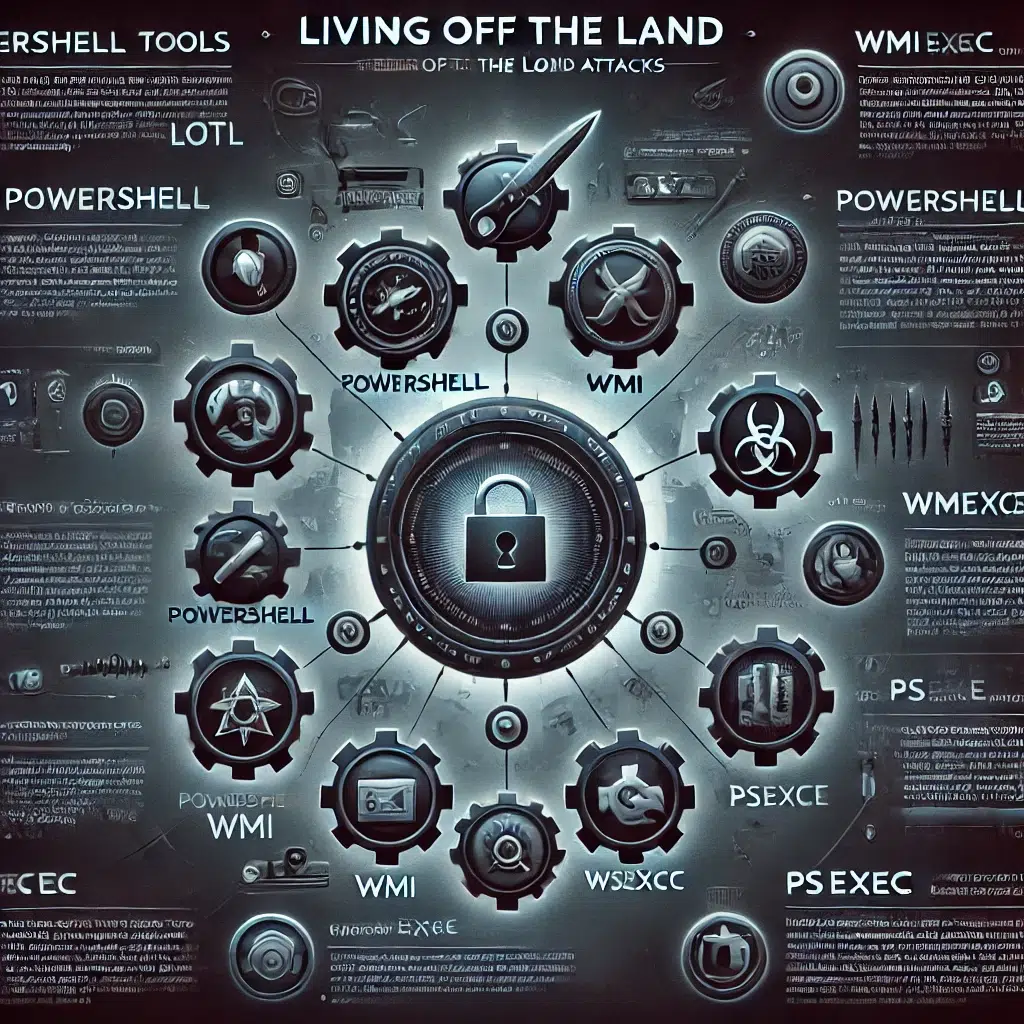Understanding Living Off the Land (LOTL) Attacks
Threat actors are continuously adapting their tactics to evade detection and infiltrate systems. One of the more sophisticated methods they employ is known as “Living Off the Land” (LOTL) attacks. This technique involves leveraging existing, legitimate tools and processes within an organization’s environment to carry out malicious activities. By using these tools, attackers can blend in with normal operations, making their actions harder to detect and trace.
This article explores the concept of LOTL attacks, provides insight into why they are so effective, and highlights the ten most common tools used by cybercriminals in these operations. This detailed analysis is designed for IT leaders, such as CISOs, CIOs, and IT Directors, to help them better understand and defend against these covert threats.
What Are Living Off the Land (LOTL) Attacks?
LOTL attacks represent a shift from traditional methods of cyber intrusion. Instead of deploying external malware or hacking tools, attackers use the tools and software already present on the target system. These are often legitimate administrative or system tools that are commonly used for day-to-day operations. By leveraging these tools, attackers can minimize their footprint, avoid triggering security alerts, and maintain persistence within the compromised environment.
The main advantage of LOTL attacks lies in their stealth. Traditional security solutions, such as antivirus programs, are designed to detect and block known malware signatures and patterns. However, when an attacker uses legitimate tools, it becomes significantly more challenging for these solutions to distinguish between normal and malicious activity.
Why LOTL Attacks Are So Effective
Several factors contribute to the effectiveness of LOTL attacks:
Trustworthiness of Tools: The tools used in LOTL attacks are typically trusted and whitelisted within the organization’s environment, making them less likely to be flagged as suspicious.
Evasion of Detection: Since these attacks use legitimate tools, they often evade detection by traditional security solutions that focus on identifying and blocking known malware.
Persistence: Attackers can maintain long-term access to compromised systems by using built-in tools, making it difficult for defenders to completely eradicate them from the environment.
Minimal Footprint: By avoiding the use of external malware, LOTL attacks leave behind minimal forensic evidence, complicating post-incident investigations.
The 10 Most Common Tools Used in LOTL Attacks
Here are the ten most commonly exploited tools by threat actors in LOTL attacks, along with explanations of how they are used:
1. PowerShell
PowerShell is a powerful scripting language and command-line shell commonly used by system administrators for task automation and configuration management. However, its versatility makes it a favorite tool for attackers. PowerShell can be used to download and execute malicious payloads, escalate privileges, and exfiltrate data, all while blending in with legitimate administrative activities.
Defense Tips:
- Implement strict execution policies.
- Monitor and log PowerShell activity.
- Disable PowerShell for users who do not need it.
2. Windows Management Instrumentation (WMI)
WMI is another tool used by administrators to manage data and operations on Windows-based systems. Attackers exploit WMI to execute remote commands, gather system information, and move laterally across the network without triggering alarms.
Defense Tips:
- Limit the use of WMI in your environment.
- Monitor WMI activity, especially for remote execution events.
- Implement least privilege access to WMI.
3. PsExec
PsExec, part of the Sysinternals suite, is a remote administration tool that allows users to execute processes on other systems. Attackers use PsExec for lateral movement and executing commands on remote systems without the need for direct access.
Defense Tips:
- Restrict access to Sysinternals tools.
- Monitor for unusual PsExec usage.
- Employ network segmentation to limit the spread of lateral movement.
4. Task Scheduler
Task Scheduler is used to schedule automated tasks on Windows systems. Attackers can create or modify scheduled tasks to persist on the system, execute payloads, or trigger malicious scripts at specific times.
Defense Tips:
- Regularly audit scheduled tasks.
- Monitor task creation and modification events.
- Restrict access to Task Scheduler where possible.
5. Regsvr32
Regsvr32 is a command-line utility used to register and unregister OLE controls like DLL files. Attackers leverage Regsvr32 to execute arbitrary code by registering malicious DLLs, often bypassing security controls.
Defense Tips:
- Monitor Regsvr32 usage for unusual activity.
- Restrict access to Regsvr32 where it’s not necessary.
- Employ application whitelisting.
6. CertUtil
CertUtil is a command-line tool used to manage certificates in Windows. Threat actors use CertUtil to download and encode malicious payloads, helping them evade detection by security solutions.
Defense Tips:
- Monitor CertUtil commands and flag suspicious use.
- Disable CertUtil on systems where it’s not required.
- Implement network monitoring to detect anomalous data exfiltration
7. Mshta.exe
Mshta.exe is a utility for executing Microsoft HTML Applications (HTA files). Attackers exploit it to execute malicious scripts and payloads under the guise of legitimate HTML applications.
Defense Tips
- Block or restrict the use of Mshta.exe.
- Monitor for HTA file execution.
- Implement strict group policies to control script execution
8. Rundll32
Rundll32 is used to execute functions exported from DLL files. Attackers can use Rundll32 to execute malicious code or scripts directly from a DLL, often without leaving behind obvious traces.
Defense Tips:
- Monitor Rundll32 execution, especially when launching from unusual paths.
- Implement application control policies.
- Regularly audit DLL files loaded on systems
9. Cmd.exe
Cmd.exe is the default command-line interpreter for Windows. While it’s essential for legitimate administration tasks, attackers use Cmd.exe for executing commands, scripts, and launching other tools within a compromised system.
Defense Tips:
- Monitor command-line usage for unusual or suspicious commands
- Restrict Cmd.exe access to necessary users only.
- Implement endpoint detection and response (EDR) solutions to flag abnormal command execution pattern
10. Bitsadmin
Bitsadmin is a command-line tool used to create download or upload jobs and monitor their progress. Attackers exploit Bitsadmin to download malicious files from remote servers, often under the radar of security tools.
Defense Tips:
- Monitor and log all Bitsadmin usage.
- Disable Bitsadmin on systems where it’s not required.
- Implement network controls to block suspicious outbound connections.
Mitigating LOTL Attacks
Given the nature of LOTL attacks, traditional security measures alone may not be sufficient to detect and prevent them. Organizations should consider implementing the following strategies:
1. Implement security solutions that focus on detecting unusual behavior, rather than relying solely on signature-based detection.
2. Enforce the principle of least privilege, ensuring that users and processes have only the minimal level of access necessary to perform their functions.
3. Restrict the execution of unauthorized applications and scripts through whitelisting to prevent malicious use of legitimate tools.
4. Conduct regular audits of system configurations, scheduled tasks, and administrative tools. Implement continuous monitoring to detect suspicious activities in real time.
5. Educate employees about the risks associated with LOTL attacks and encourage them to report any unusual system behavior or performance issues.
Conclusion
Living Off the Land (LOTL) attacks represent a significant challenge for IT leaders, as they leverage legitimate tools and processes to carry out malicious activities, often under the radar of traditional security measures. Understanding the tools commonly exploited in LOTL attacks and implementing robust monitoring and defense strategies are essential steps in mitigating these threats.
By staying informed and vigilant, CISOs, CIOs, and IT Directors can better protect their organizations from these stealthy and sophisticated attacks, ensuring a more resilient security posture in the face of evolving cyber threats.`





